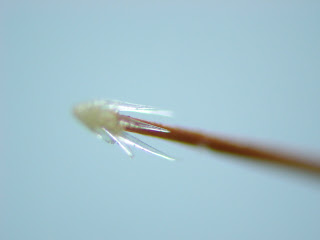The simple sharing capabilities in Google Apps for Education can create amazing opportunities for resource sharing and collaboration.
In the South-Weston Network, schools have gotten together to form a resource-sharing network. A simple shared folder outlines all the available resources, and a shared calendar assists with bookings.
One of the best things to come out of this is the ability for the network to share their amazing new purchase, a state-of-the art microscope setup, which makes it possible for the budding scientists across the network to see microscopic parts of the world that they've never seen before.
The microscope, currently housed at Stromlo High school, is connected to a high-resolution digital camera that produces incredible macro images and videos at up to 90x magnification. Stromlo High's science SLC Stefan gave me a demonstration.
|
|
| So this is why the seeds always stick to my socks! |
 |
| Weeds are so much more beautiful in macro. |
 |
| And so are spiders! |
The size of the files are probably too big to share any other way, but having them in a shared Google Drive folder means that everyone can access these amazing images. Perhaps for some scientific inquiry about the microscopic world, but perhaps for other things too: Art? Creative writing? Graphic design?
As we talked, Stefan put lots of things under the microscope. The images were projected in beautiful detail on the classroom wall. Considering how fascinated I was, I wondered about the other students and teachers in the school.
 |
| This is the Twitter app icon on an iPhone. |
Of course, it's engaging for students. Imagine having such easy access to a world they can't actually see; and insight into the tiny things that make up life. But the cool thing is also how much the teachers engage. Stefan said that once a teacher's been in and tried out the microscope, they want to come back again and again.
 |
| Look at the size of this eye compared to the face! |
But the best bit (I think) is the tangents. Primary school teachers are pretty good at allowing the odd tangent. You've got to when your kids are coming in with a whole lot of random, exciting experiences fresh in their minds. In high school that's maybe less common. But still important. Looking at something unknown within something very familiar can spark the most amazing conversations. And that's when learning is at its best.
As Stefan says, science learning is most effective when it's "exciting, wondrous and cool". Actually, probably all learning is. And it's these wonderful little technology additions that make it possible.
 |
| This was my favourite thing. This 2cm washer has a little spot of rust on it. |
And this was what was in the rust!





Hi Stefan @ Mount Stromlo. Do you still use this microscope? Please give brand name and model number? Thanks
ReplyDelete